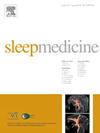Perspectives regarding consumer sleep technology and barriers to its use or adoption among adults in the United States
IF 3.8
2区 医学
Q1 CLINICAL NEUROLOGY
引用次数: 0
Abstract
Objective
To explore perspectives about consumer sleep technology (CST) and barriers to its regular use and whether these vary by sociodemographic characteristics.
Methods
A multidisciplinary team developed a survey instrument which was disseminated to a national sample via an online platform. A mixed methods analysis using descriptive statistics, logistic regression, and thematic content analysis was employed.
Results
Among 897 survey respondents, mean age was 47.5 ± 16.9 years; 73.1 % identified as female, and 81.8 % as White. A total of 505 respondents (56.3 %) reported having tracked their sleep using CST. Concerns or barriers reported by respondents included cost (57.2 %), too many different types of CST (56.5 %), and data privacy/security concerns (38.7 %). Younger individuals (p < 0.001) and those with annual household income $30,000 to $57,999 per year (p = 0.006) or <$30,000 per year (p = 0.021) were more likely to report cost as a barrier in the adjusted analysis. Individuals with household income <$30,000 (p = 0.004) or identifying as Asian (p = 0.002) or Black (p = 0.004) race were more likely to report data privacy/security concerns. Among those who already owned CST, 12.3 % reported sleep-related worry/orthosomnia and 17 % reported not trusting the data. Qualitative analyses corroborated these findings, emphasizing concerns with data privacy/security, sleep-related worry, lack of trust in data accuracy, and physical discomfort.
Conclusions
Despite the growing popularity of CST, there exist several concerns and barriers to its regular use that may have health equity implications. Further research incorporating diverse stakeholders is necessary to address these barriers and promote optimal use of technology.

求助全文
约1分钟内获得全文
求助全文
来源期刊

Sleep medicine
医学-临床神经学
CiteScore
8.40
自引率
6.20%
发文量
1060
审稿时长
49 days
期刊介绍:
Sleep Medicine aims to be a journal no one involved in clinical sleep medicine can do without.
A journal primarily focussing on the human aspects of sleep, integrating the various disciplines that are involved in sleep medicine: neurology, clinical neurophysiology, internal medicine (particularly pulmonology and cardiology), psychology, psychiatry, sleep technology, pediatrics, neurosurgery, otorhinolaryngology, and dentistry.
The journal publishes the following types of articles: Reviews (also intended as a way to bridge the gap between basic sleep research and clinical relevance); Original Research Articles; Full-length articles; Brief communications; Controversies; Case reports; Letters to the Editor; Journal search and commentaries; Book reviews; Meeting announcements; Listing of relevant organisations plus web sites.
 求助内容:
求助内容: 应助结果提醒方式:
应助结果提醒方式:


